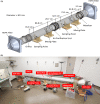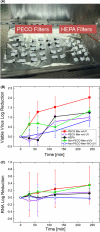Wind tunnel-based testing of a photoelectrochemical oxidative filter-based air purification unit in coronavirus and influenza aerosol removal and inactivation
- PMID: 33960547
- PMCID: PMC8242653
- DOI: 10.1111/ina.12847
Wind tunnel-based testing of a photoelectrochemical oxidative filter-based air purification unit in coronavirus and influenza aerosol removal and inactivation
Abstract
Recirculating air purification technologies are employed as potential means of reducing exposure to aerosol particles and airborne viruses. Toward improved testing of recirculating air purification units, we developed and applied a medium-scale single-pass wind tunnel test to examine the size-dependent collection of particles and the collection and inactivation of viable bovine coronavirus (BCoV, a betacoronavirus), porcine respiratory coronavirus (PRCV, an alphacoronavirus), and influenza A virus (IAV), by a commercial air purification unit. The tested unit, the Molekule Air Mini, incorporates a MERV 16 filter as well as a photoelectrochemical oxidating layer. It was found to have a collection efficiency above 95.8% for all tested particle diameters and flow rates, with collection efficiencies above 99% for supermicrometer particles with the minimum collection efficiency for particles smaller than 100 nm. For all three tested viruses, the physical tracer-based log reduction was near 2.0 (99% removal). Conversely, the viable virus log reductions were found to be near 4.0 for IAV, 3.0 for BCoV, and 2.5 for PRCV, suggesting additional inactivation in a virus family- and genus-specific manner. In total, this work describes a suite of test methods which can be used to rigorously evaluate the efficacy of recirculating air purification technologies.
Keywords: air purifier; coronavirus; filtration; influenza; photoelectrochemical oxidation; virus aerosols; wind tunnel test.
© 2021 John Wiley & Sons A/S. Published by John Wiley & Sons Ltd.
Conflict of interest statement
None of the authors have any financial or personal interests related to the results of this study.
Figures




References
-
- Liu Y, Ning Z, Chen Y, et al. Aerodynamic analysis of SARS‐CoV‐2 in two Wuhan hospitals. Nature. 2020;582(7813):557‐560. - PubMed
MeSH terms
Substances
Grants and funding
LinkOut - more resources
Full Text Sources
Other Literature Sources
Medical

